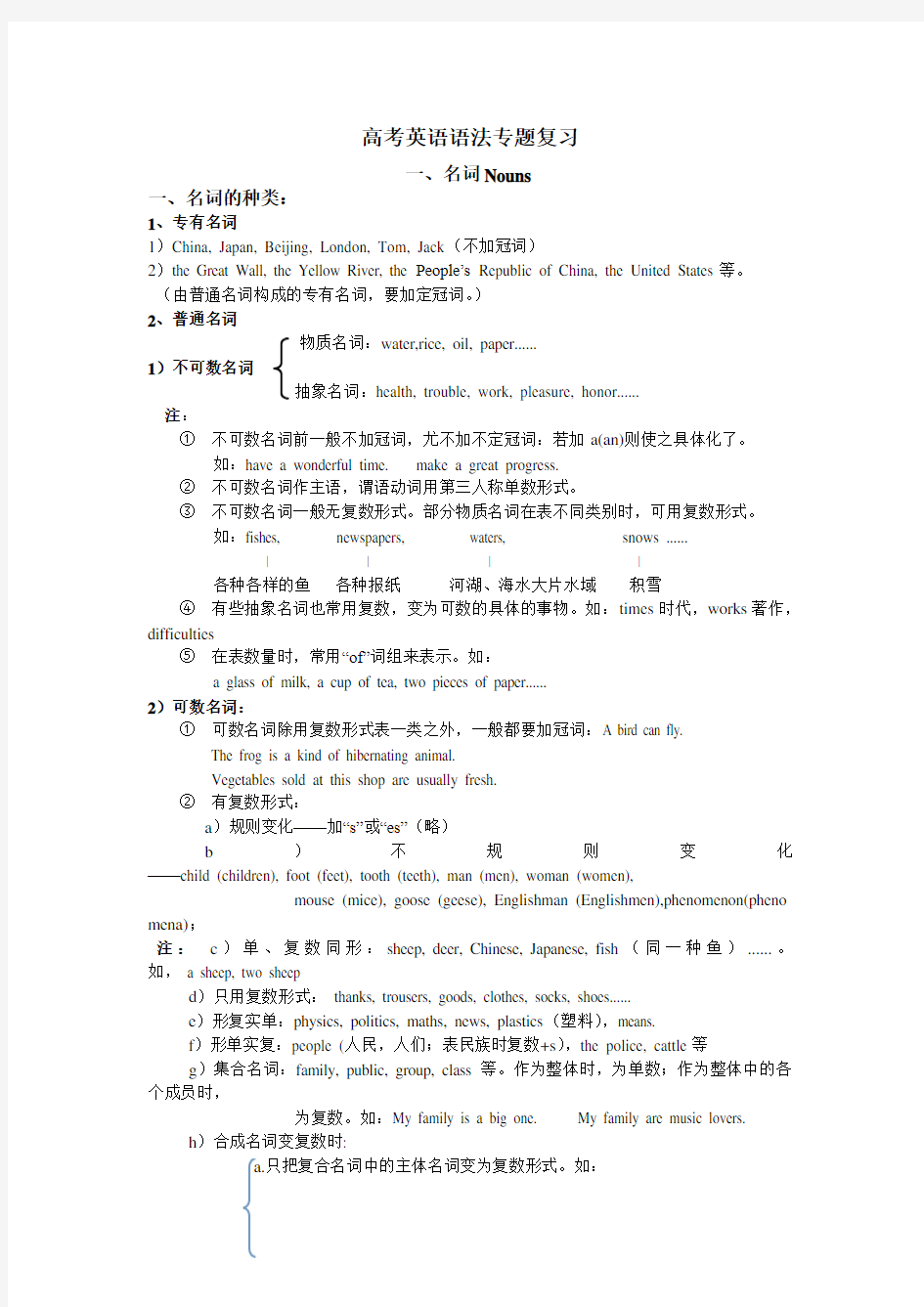
(完整word版)高考英语语法专题复习--名词
- 格式:doc
- 大小:45.56 KB
- 文档页数:3


高考英语语法专题复习
一、名词Nouns
一、名词的种类:
1、专有名词
1)China, Japan, Beijing, London, Tom, Jack(不加冠词)
2)the Great Wall, the Yellow River, the People’s Republic of China, the United States等。
(由普通名词构成的专有名词,要加定冠词。)
2、普通名词
物质名词:water,rice, oil, paper......
1)不可数名词
抽象名词:health, trouble, work, pleasure, honor......
注:
①不可数名词前一般不加冠词,尤不加不定冠词:若加a(an)则使之具体化了。
如:have a wonderful time. make a great progress.
②不可数名词作主语,谓语动词用第三人称单数形式。
③不可数名词一般无复数形式。部分物质名词在表不同类别时,可用复数形式。
如:fishes, newspapers, waters, snows ......
| | | |
各种各样的鱼各种报纸河湖、海水大片水域积雪
④有些抽象名词也常用复数,变为可数的具体的事物。如:times时代,works著作,difficulties
⑤在表数量时,常用“of”词组来表示。如:
a glass of milk, a cup of tea, two pieces of paper......
2)可数名词:
①可数名词除用复数形式表一类之外,一般都要加冠词:A bird can fly.
The frog is a kind of hibernating animal.
Vegetables sold at this shop are usually fresh.
②有复数形式:
a)规则变化——加“s”或“es”(略)
b)不规则变化——child (children), foot (feet), tooth (teeth), man (men), woman (women),
mouse (mice), goose (geese), Englishman (Englishmen),phenomenon(pheno mena);
注:c)单、复数同形:sheep, deer, Chinese, Japanese, fish(同一种鱼)......。如, a sheep, two sheep
d)只用复数形式: thanks, trousers, goods, clothes, socks, shoes......
e)形复实单:physics, politics, maths, news, plastics(塑料),means.
f)形单实复:people (人民,人们;表民族时复数+s),the police, cattle等
g)集合名词:family, public, group, class等。作为整体时,为单数;作为整体中的各个成员时,
为复数。如:My family is a big one. My family are music lovers.
h)合成名词变复数时:
a.只把复合名词中的主体名词变为复数形式。如:
sister(s)-in-law嫂子,弟妹;step-son (s)继子;editor (s) -in-chief总编辑。
b.没有主体名词在最后一个词的后面加“s”。如:grown-up(s)成年人,go-between(s)中间人
c.woman, man作定语时,要与被修饰的名词的数一致。如:
a man servant—men servants, a woman doctor—women doctors
二、名词的所有格
1、表有生命的东西(人或动物)的名词所有格,一般在名词后加“’s”。如:
Mike’s bag, Children’s Day, my brother’s room, women’s rights。
注:
①名词复数的词尾是-s或-es,它的所有格只在词后加“’”。如:
Teachers’ Day, the workers’ rest-home(工人疗养院),the students’ reading-room
②复合名词的所有格,在后面的词后加“’s”。如:
her son-in-law’s photo(她女婿的照片);anybody else’s book(其他任何人的书)
③如果一样东西为两人或两人以上共有,则在最后的一个名词后面加“’s”; 如果不是共有,则每个词后都要加“’s”。如:
Jane and Helen’s room. 珍妮和海伦的房间(共有).
Bill’s and Tom’s radios. 比尔的收音机和汤姆的收音机(不共有)
④表地点(店铺,某人的家等)的名词所有格后面,一般省去它所修饰的名词。如:
the tailor’s (裁缝铺) the doctor’s (诊所) Mr Brown’s (布朗先生的家)
⑤有些表时间、距离、国家、城镇的无生命的名词,也可加“’s”表所有格。如:
half an hour’s walk (半小时的路程) China’s agriculture (中国的农业)
2、表示无生命的东西的名词一般与of构成词组,表示所有格。如:the cover of the book
3、表示有生命的东西的名词也可以用of,特别是名词较长,有较多的定语时。如:
the story of Dr Norman Bethune Do you know the name of the boy standing at the gate? 4、双重所有格:“名词+of+名词所有格”/名词+of+名词性物主代词
在表示所属物的名词前有冠词、数词、不定代词或指示代词(如:a, two, some, a few, this, that, these,
those等)时,常用“of词组+所有格”的形式来表示所有关系。如:
a friend of my father’s 我父亲的一位朋友。
some students of mine. 我的一些学生。
those exercise-books of the students’学生们的那些练习本。
【专项训练】:
1、There are only twelve in the hospital.
A.woman doctors B.women doctors C.women doctor D.woman doctor
2、Mr Smith has two , both of whom are teachers in a school.
A.brothers-in-law B.brother-in-laws C.brothers-in-laws D.brothers-in law 3、——How many does a cow have? ——Four.
A.stomaches B.stomach C.stomachs D.stomachies
4、Some visited our school last Wednesday.
A.German B.Germen C.Germans D.Germens
5、The of the building are covered with lots of .